University Report: Sustainable Construction and Glulam Analysis
VerifiedAdded on 2022/08/31
|24
|6023
|20
Report
AI Summary
This report delves into the realm of sustainable construction, focusing on the use of Glulam as a key material. It explores the building and construction industry's impact on the environment, highlighting the significant waste generation and resource consumption. The report examines waste management strategies, including procurement practices and case studies such as the Ipswich Hospital project, and Tekniska Verken. A SWOT analysis of these strategies is provided. The report also covers Lean construction, including its principles and applications, with a case study of St. Olav's Integrated Hospital in Norway. The report concludes with an analysis of Glulam's role in green building and construction and the potential for reducing environmental impact by adopting sustainable construction practices. The report also includes a discussion of waste management, procurement strategies, and lean construction principles.
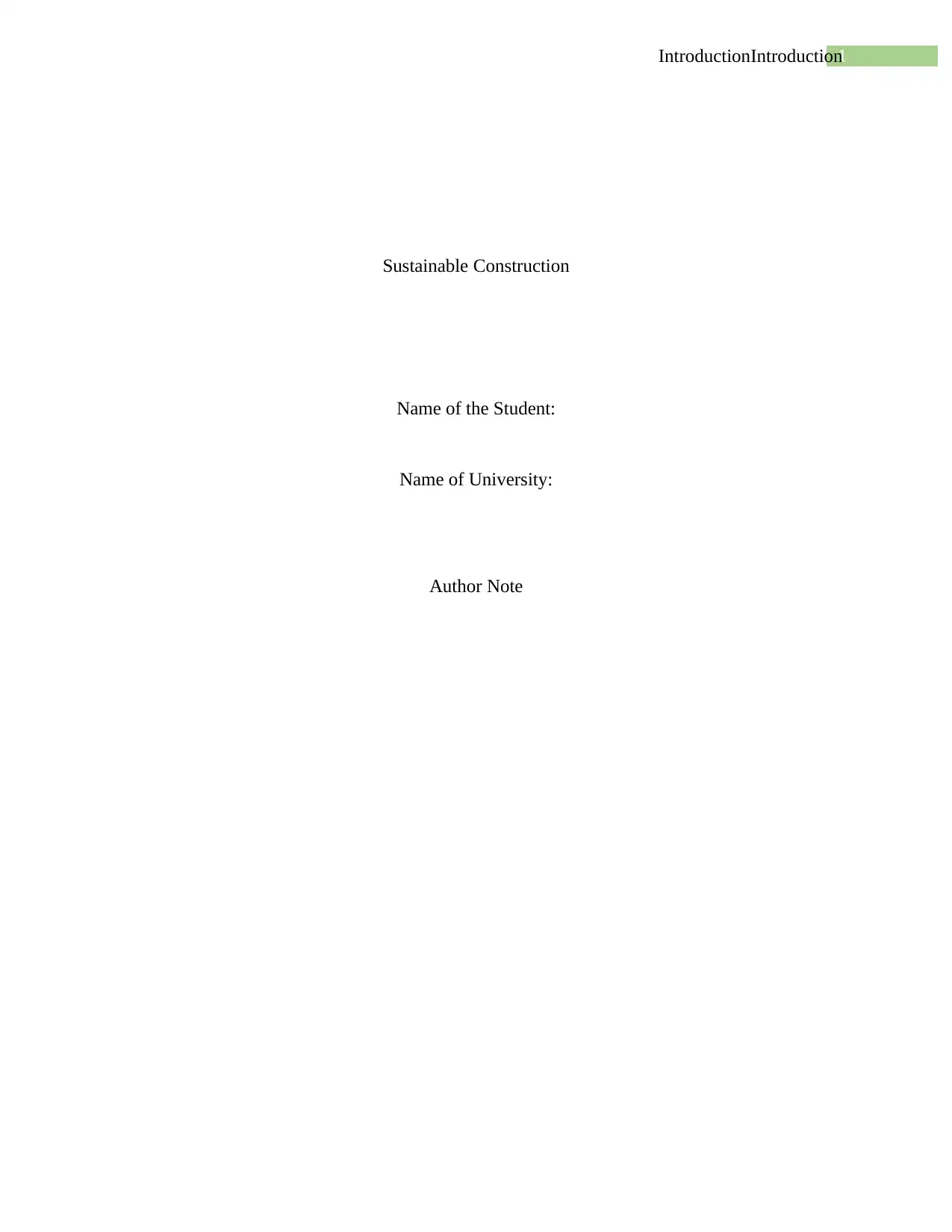
1IntroductionIntroduction
Sustainable Construction
Name of the Student:
Name of University:
Author Note
Sustainable Construction
Name of the Student:
Name of University:
Author Note
Paraphrase This Document
Need a fresh take? Get an instant paraphrase of this document with our AI Paraphraser
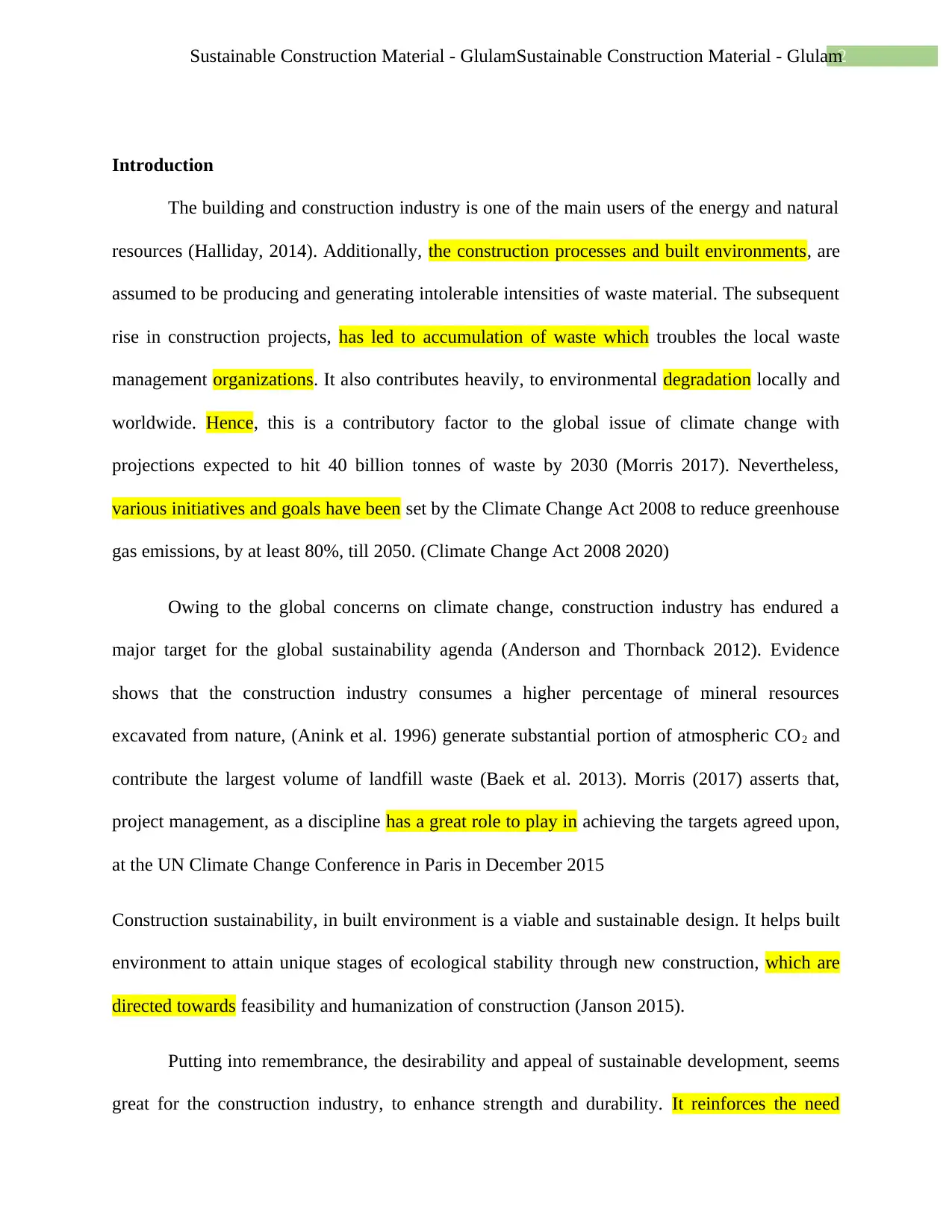
2Sustainable Construction Material - GlulamSustainable Construction Material - Glulam
Introduction
The building and construction industry is one of the main users of the energy and natural
resources (Halliday, 2014). Additionally, the construction processes and built environments, are
assumed to be producing and generating intolerable intensities of waste material. The subsequent
rise in construction projects, has led to accumulation of waste which troubles the local waste
management organizations. It also contributes heavily, to environmental degradation locally and
worldwide. Hence, this is a contributory factor to the global issue of climate change with
projections expected to hit 40 billion tonnes of waste by 2030 (Morris 2017). Nevertheless,
various initiatives and goals have been set by the Climate Change Act 2008 to reduce greenhouse
gas emissions, by at least 80%, till 2050. (Climate Change Act 2008 2020)
Owing to the global concerns on climate change, construction industry has endured a
major target for the global sustainability agenda (Anderson and Thornback 2012). Evidence
shows that the construction industry consumes a higher percentage of mineral resources
excavated from nature, (Anink et al. 1996) generate substantial portion of atmospheric CO2 and
contribute the largest volume of landfill waste (Baek et al. 2013). Morris (2017) asserts that,
project management, as a discipline has a great role to play in achieving the targets agreed upon,
at the UN Climate Change Conference in Paris in December 2015
Construction sustainability, in built environment is a viable and sustainable design. It helps built
environment to attain unique stages of ecological stability through new construction, which are
directed towards feasibility and humanization of construction (Janson 2015).
Putting into remembrance, the desirability and appeal of sustainable development, seems
great for the construction industry, to enhance strength and durability. It reinforces the need
Introduction
The building and construction industry is one of the main users of the energy and natural
resources (Halliday, 2014). Additionally, the construction processes and built environments, are
assumed to be producing and generating intolerable intensities of waste material. The subsequent
rise in construction projects, has led to accumulation of waste which troubles the local waste
management organizations. It also contributes heavily, to environmental degradation locally and
worldwide. Hence, this is a contributory factor to the global issue of climate change with
projections expected to hit 40 billion tonnes of waste by 2030 (Morris 2017). Nevertheless,
various initiatives and goals have been set by the Climate Change Act 2008 to reduce greenhouse
gas emissions, by at least 80%, till 2050. (Climate Change Act 2008 2020)
Owing to the global concerns on climate change, construction industry has endured a
major target for the global sustainability agenda (Anderson and Thornback 2012). Evidence
shows that the construction industry consumes a higher percentage of mineral resources
excavated from nature, (Anink et al. 1996) generate substantial portion of atmospheric CO2 and
contribute the largest volume of landfill waste (Baek et al. 2013). Morris (2017) asserts that,
project management, as a discipline has a great role to play in achieving the targets agreed upon,
at the UN Climate Change Conference in Paris in December 2015
Construction sustainability, in built environment is a viable and sustainable design. It helps built
environment to attain unique stages of ecological stability through new construction, which are
directed towards feasibility and humanization of construction (Janson 2015).
Putting into remembrance, the desirability and appeal of sustainable development, seems
great for the construction industry, to enhance strength and durability. It reinforces the need
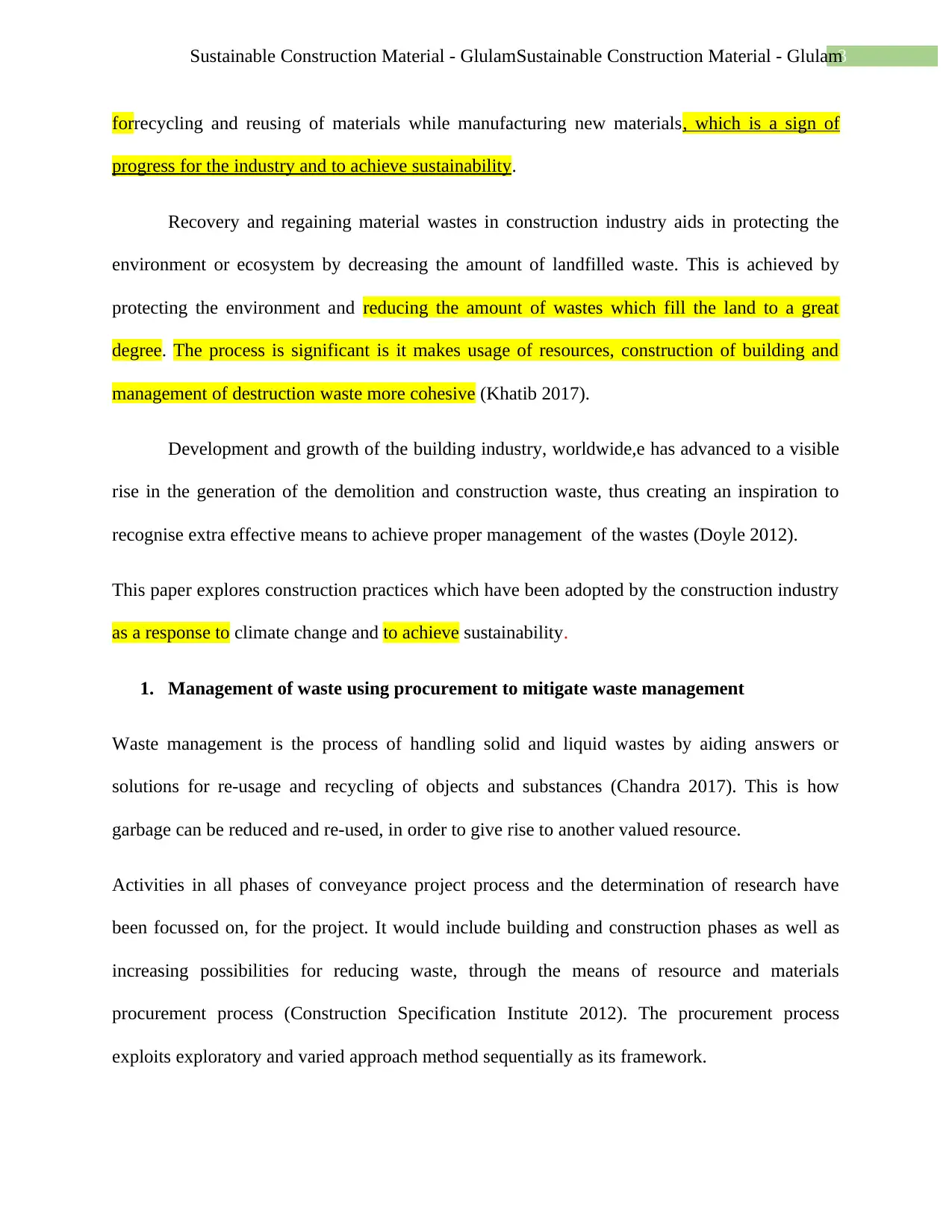
3Sustainable Construction Material - GlulamSustainable Construction Material - Glulam
forrecycling and reusing of materials while manufacturing new materials, which is a sign of
progress for the industry and to achieve sustainability.
Recovery and regaining material wastes in construction industry aids in protecting the
environment or ecosystem by decreasing the amount of landfilled waste. This is achieved by
protecting the environment and reducing the amount of wastes which fill the land to a great
degree. The process is significant is it makes usage of resources, construction of building and
management of destruction waste more cohesive (Khatib 2017).
Development and growth of the building industry, worldwide,e has advanced to a visible
rise in the generation of the demolition and construction waste, thus creating an inspiration to
recognise extra effective means to achieve proper management of the wastes (Doyle 2012).
This paper explores construction practices which have been adopted by the construction industry
as a response to climate change and to achieve sustainability.
1. Management of waste using procurement to mitigate waste management
Waste management is the process of handling solid and liquid wastes by aiding answers or
solutions for re-usage and recycling of objects and substances (Chandra 2017). This is how
garbage can be reduced and re-used, in order to give rise to another valued resource.
Activities in all phases of conveyance project process and the determination of research have
been focussed on, for the project. It would include building and construction phases as well as
increasing possibilities for reducing waste, through the means of resource and materials
procurement process (Construction Specification Institute 2012). The procurement process
exploits exploratory and varied approach method sequentially as its framework.
forrecycling and reusing of materials while manufacturing new materials, which is a sign of
progress for the industry and to achieve sustainability.
Recovery and regaining material wastes in construction industry aids in protecting the
environment or ecosystem by decreasing the amount of landfilled waste. This is achieved by
protecting the environment and reducing the amount of wastes which fill the land to a great
degree. The process is significant is it makes usage of resources, construction of building and
management of destruction waste more cohesive (Khatib 2017).
Development and growth of the building industry, worldwide,e has advanced to a visible
rise in the generation of the demolition and construction waste, thus creating an inspiration to
recognise extra effective means to achieve proper management of the wastes (Doyle 2012).
This paper explores construction practices which have been adopted by the construction industry
as a response to climate change and to achieve sustainability.
1. Management of waste using procurement to mitigate waste management
Waste management is the process of handling solid and liquid wastes by aiding answers or
solutions for re-usage and recycling of objects and substances (Chandra 2017). This is how
garbage can be reduced and re-used, in order to give rise to another valued resource.
Activities in all phases of conveyance project process and the determination of research have
been focussed on, for the project. It would include building and construction phases as well as
increasing possibilities for reducing waste, through the means of resource and materials
procurement process (Construction Specification Institute 2012). The procurement process
exploits exploratory and varied approach method sequentially as its framework.
⊘ This is a preview!⊘
Do you want full access?
Subscribe today to unlock all pages.

Trusted by 1+ million students worldwide
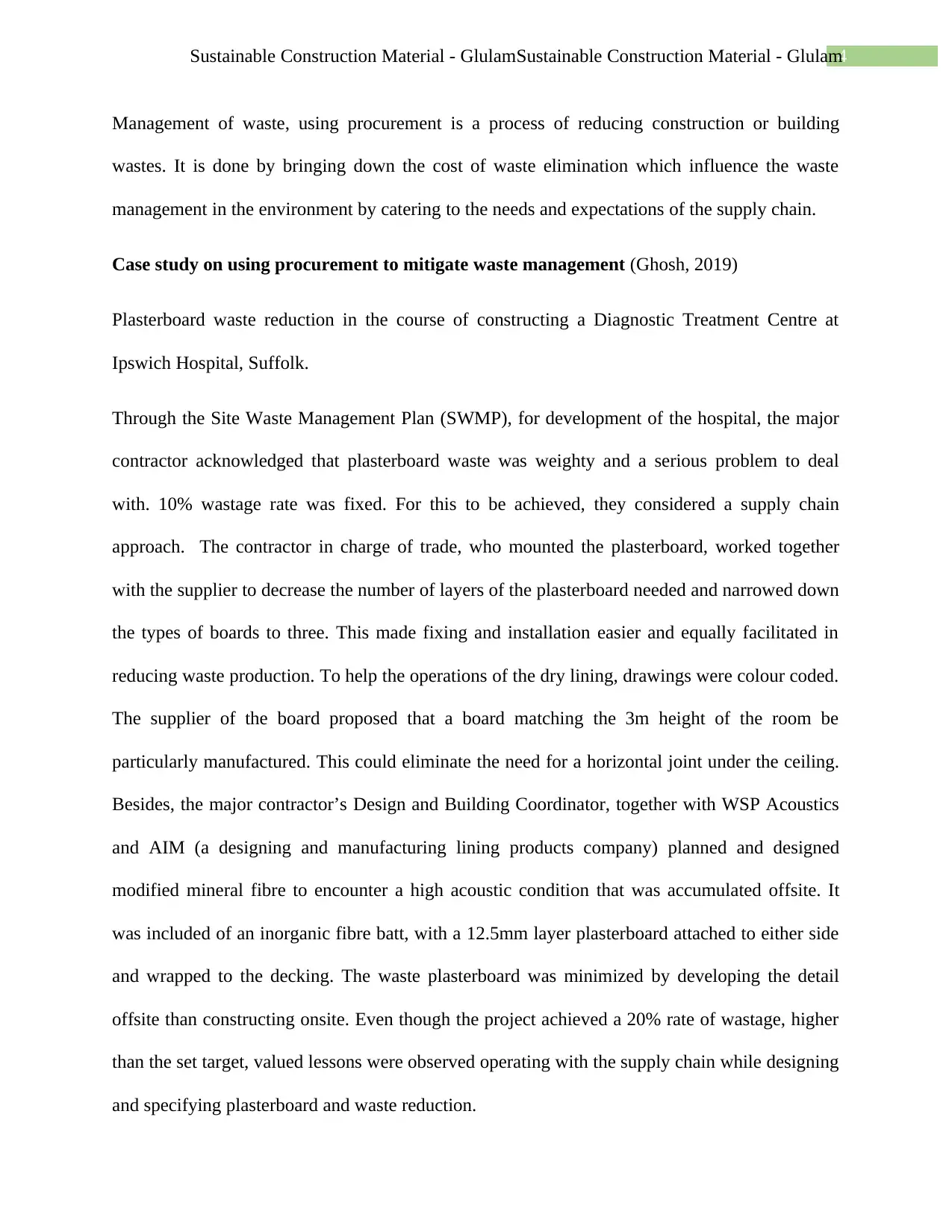
4Sustainable Construction Material - GlulamSustainable Construction Material - Glulam
Management of waste, using procurement is a process of reducing construction or building
wastes. It is done by bringing down the cost of waste elimination which influence the waste
management in the environment by catering to the needs and expectations of the supply chain.
Case study on using procurement to mitigate waste management (Ghosh, 2019)
Plasterboard waste reduction in the course of constructing a Diagnostic Treatment Centre at
Ipswich Hospital, Suffolk.
Through the Site Waste Management Plan (SWMP), for development of the hospital, the major
contractor acknowledged that plasterboard waste was weighty and a serious problem to deal
with. 10% wastage rate was fixed. For this to be achieved, they considered a supply chain
approach. The contractor in charge of trade, who mounted the plasterboard, worked together
with the supplier to decrease the number of layers of the plasterboard needed and narrowed down
the types of boards to three. This made fixing and installation easier and equally facilitated in
reducing waste production. To help the operations of the dry lining, drawings were colour coded.
The supplier of the board proposed that a board matching the 3m height of the room be
particularly manufactured. This could eliminate the need for a horizontal joint under the ceiling.
Besides, the major contractor’s Design and Building Coordinator, together with WSP Acoustics
and AIM (a designing and manufacturing lining products company) planned and designed
modified mineral fibre to encounter a high acoustic condition that was accumulated offsite. It
was included of an inorganic fibre batt, with a 12.5mm layer plasterboard attached to either side
and wrapped to the decking. The waste plasterboard was minimized by developing the detail
offsite than constructing onsite. Even though the project achieved a 20% rate of wastage, higher
than the set target, valued lessons were observed operating with the supply chain while designing
and specifying plasterboard and waste reduction.
Management of waste, using procurement is a process of reducing construction or building
wastes. It is done by bringing down the cost of waste elimination which influence the waste
management in the environment by catering to the needs and expectations of the supply chain.
Case study on using procurement to mitigate waste management (Ghosh, 2019)
Plasterboard waste reduction in the course of constructing a Diagnostic Treatment Centre at
Ipswich Hospital, Suffolk.
Through the Site Waste Management Plan (SWMP), for development of the hospital, the major
contractor acknowledged that plasterboard waste was weighty and a serious problem to deal
with. 10% wastage rate was fixed. For this to be achieved, they considered a supply chain
approach. The contractor in charge of trade, who mounted the plasterboard, worked together
with the supplier to decrease the number of layers of the plasterboard needed and narrowed down
the types of boards to three. This made fixing and installation easier and equally facilitated in
reducing waste production. To help the operations of the dry lining, drawings were colour coded.
The supplier of the board proposed that a board matching the 3m height of the room be
particularly manufactured. This could eliminate the need for a horizontal joint under the ceiling.
Besides, the major contractor’s Design and Building Coordinator, together with WSP Acoustics
and AIM (a designing and manufacturing lining products company) planned and designed
modified mineral fibre to encounter a high acoustic condition that was accumulated offsite. It
was included of an inorganic fibre batt, with a 12.5mm layer plasterboard attached to either side
and wrapped to the decking. The waste plasterboard was minimized by developing the detail
offsite than constructing onsite. Even though the project achieved a 20% rate of wastage, higher
than the set target, valued lessons were observed operating with the supply chain while designing
and specifying plasterboard and waste reduction.
Paraphrase This Document
Need a fresh take? Get an instant paraphrase of this document with our AI Paraphraser
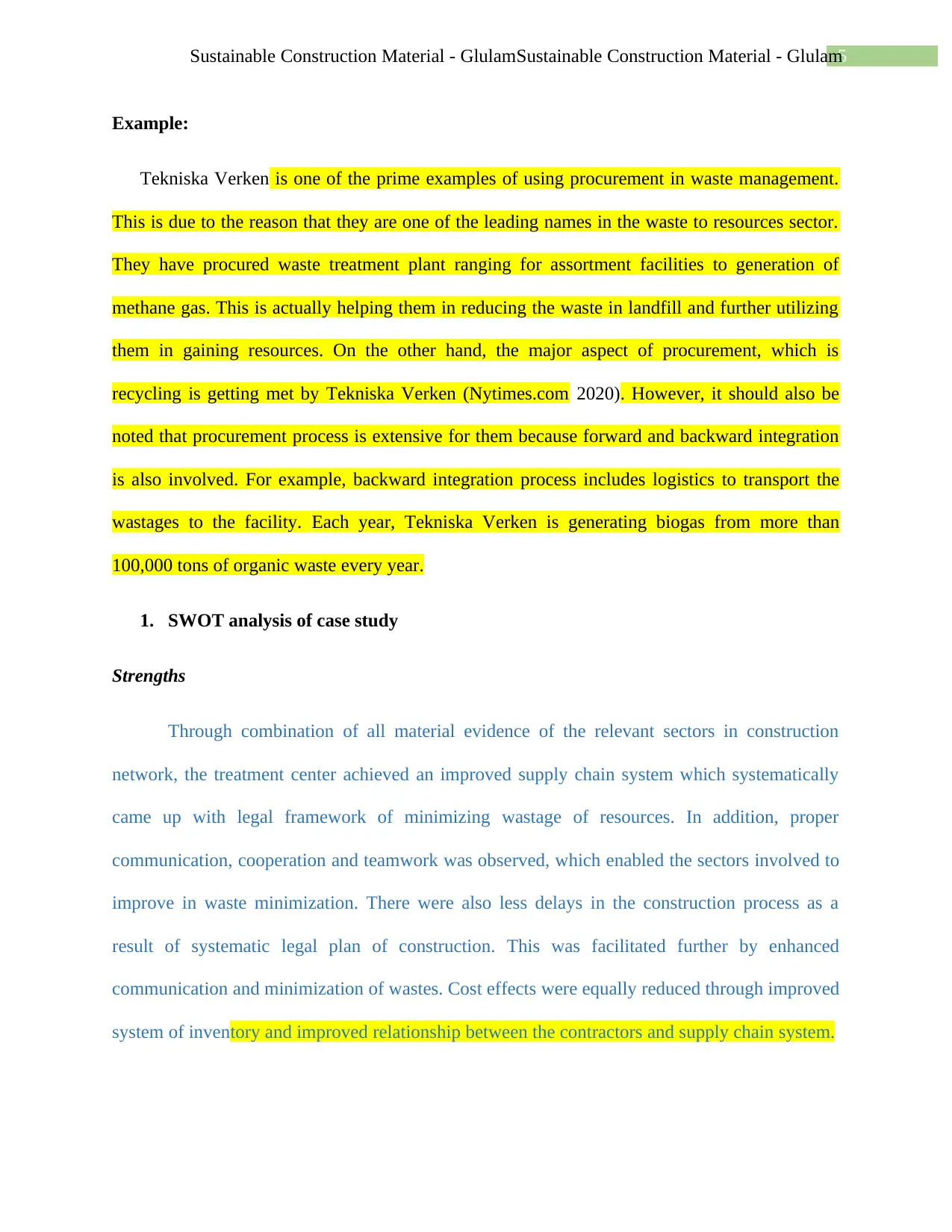
5Sustainable Construction Material - GlulamSustainable Construction Material - Glulam
Example:
Tekniska Verken is one of the prime examples of using procurement in waste management.
This is due to the reason that they are one of the leading names in the waste to resources sector.
They have procured waste treatment plant ranging for assortment facilities to generation of
methane gas. This is actually helping them in reducing the waste in landfill and further utilizing
them in gaining resources. On the other hand, the major aspect of procurement, which is
recycling is getting met by Tekniska Verken (Nytimes.com 2020). However, it should also be
noted that procurement process is extensive for them because forward and backward integration
is also involved. For example, backward integration process includes logistics to transport the
wastages to the facility. Each year, Tekniska Verken is generating biogas from more than
100,000 tons of organic waste every year.
1. SWOT analysis of case study
Strengths
Through combination of all material evidence of the relevant sectors in construction
network, the treatment center achieved an improved supply chain system which systematically
came up with legal framework of minimizing wastage of resources. In addition, proper
communication, cooperation and teamwork was observed, which enabled the sectors involved to
improve in waste minimization. There were also less delays in the construction process as a
result of systematic legal plan of construction. This was facilitated further by enhanced
communication and minimization of wastes. Cost effects were equally reduced through improved
system of inventory and improved relationship between the contractors and supply chain system.
Example:
Tekniska Verken is one of the prime examples of using procurement in waste management.
This is due to the reason that they are one of the leading names in the waste to resources sector.
They have procured waste treatment plant ranging for assortment facilities to generation of
methane gas. This is actually helping them in reducing the waste in landfill and further utilizing
them in gaining resources. On the other hand, the major aspect of procurement, which is
recycling is getting met by Tekniska Verken (Nytimes.com 2020). However, it should also be
noted that procurement process is extensive for them because forward and backward integration
is also involved. For example, backward integration process includes logistics to transport the
wastages to the facility. Each year, Tekniska Verken is generating biogas from more than
100,000 tons of organic waste every year.
1. SWOT analysis of case study
Strengths
Through combination of all material evidence of the relevant sectors in construction
network, the treatment center achieved an improved supply chain system which systematically
came up with legal framework of minimizing wastage of resources. In addition, proper
communication, cooperation and teamwork was observed, which enabled the sectors involved to
improve in waste minimization. There were also less delays in the construction process as a
result of systematic legal plan of construction. This was facilitated further by enhanced
communication and minimization of wastes. Cost effects were equally reduced through improved
system of inventory and improved relationship between the contractors and supply chain system.
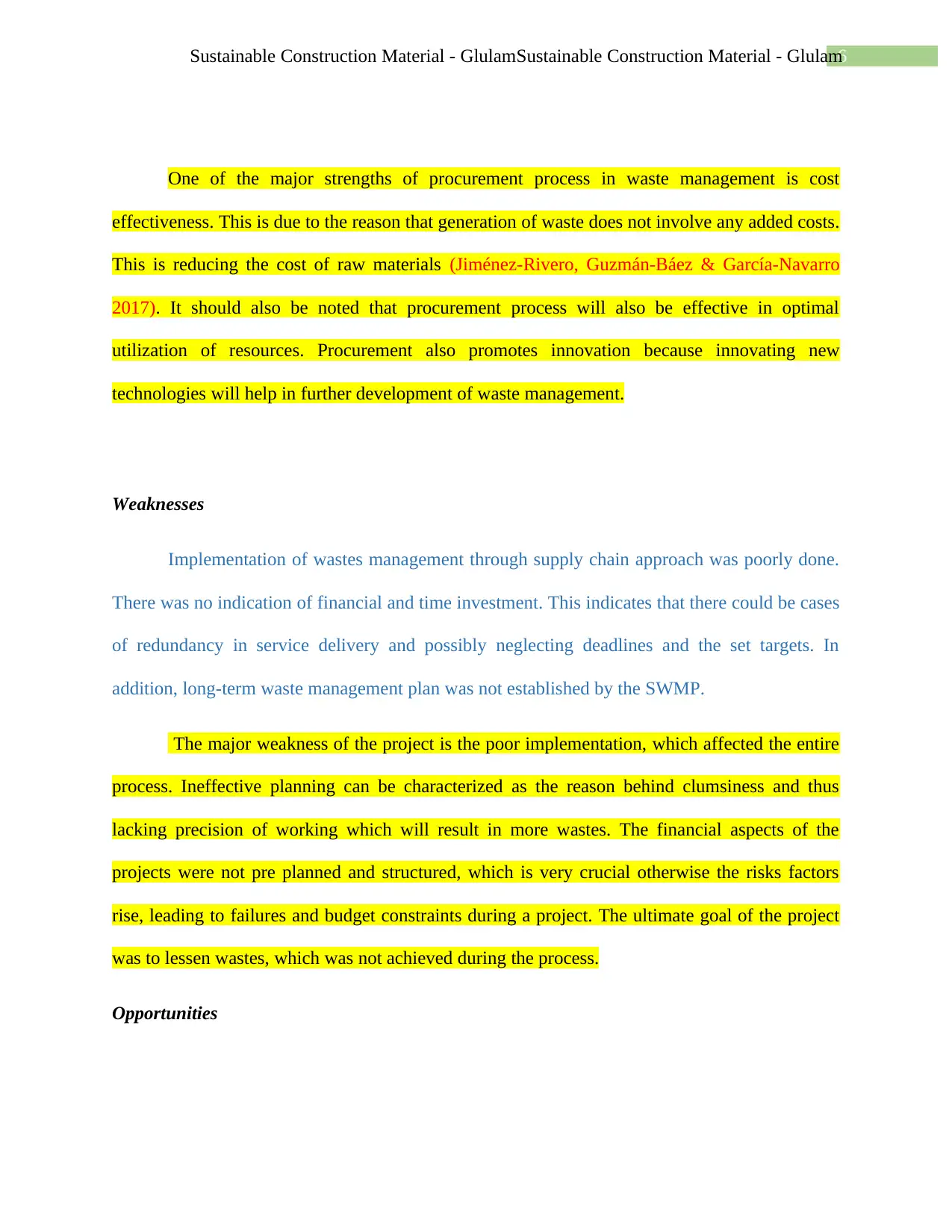
6Sustainable Construction Material - GlulamSustainable Construction Material - Glulam
One of the major strengths of procurement process in waste management is cost
effectiveness. This is due to the reason that generation of waste does not involve any added costs.
This is reducing the cost of raw materials (Jiménez-Rivero, Guzmán-Báez & García-Navarro
2017). It should also be noted that procurement process will also be effective in optimal
utilization of resources. Procurement also promotes innovation because innovating new
technologies will help in further development of waste management.
Weaknesses
Implementation of wastes management through supply chain approach was poorly done.
There was no indication of financial and time investment. This indicates that there could be cases
of redundancy in service delivery and possibly neglecting deadlines and the set targets. In
addition, long-term waste management plan was not established by the SWMP.
The major weakness of the project is the poor implementation, which affected the entire
process. Ineffective planning can be characterized as the reason behind clumsiness and thus
lacking precision of working which will result in more wastes. The financial aspects of the
projects were not pre planned and structured, which is very crucial otherwise the risks factors
rise, leading to failures and budget constraints during a project. The ultimate goal of the project
was to lessen wastes, which was not achieved during the process.
Opportunities
One of the major strengths of procurement process in waste management is cost
effectiveness. This is due to the reason that generation of waste does not involve any added costs.
This is reducing the cost of raw materials (Jiménez-Rivero, Guzmán-Báez & García-Navarro
2017). It should also be noted that procurement process will also be effective in optimal
utilization of resources. Procurement also promotes innovation because innovating new
technologies will help in further development of waste management.
Weaknesses
Implementation of wastes management through supply chain approach was poorly done.
There was no indication of financial and time investment. This indicates that there could be cases
of redundancy in service delivery and possibly neglecting deadlines and the set targets. In
addition, long-term waste management plan was not established by the SWMP.
The major weakness of the project is the poor implementation, which affected the entire
process. Ineffective planning can be characterized as the reason behind clumsiness and thus
lacking precision of working which will result in more wastes. The financial aspects of the
projects were not pre planned and structured, which is very crucial otherwise the risks factors
rise, leading to failures and budget constraints during a project. The ultimate goal of the project
was to lessen wastes, which was not achieved during the process.
Opportunities
⊘ This is a preview!⊘
Do you want full access?
Subscribe today to unlock all pages.

Trusted by 1+ million students worldwide
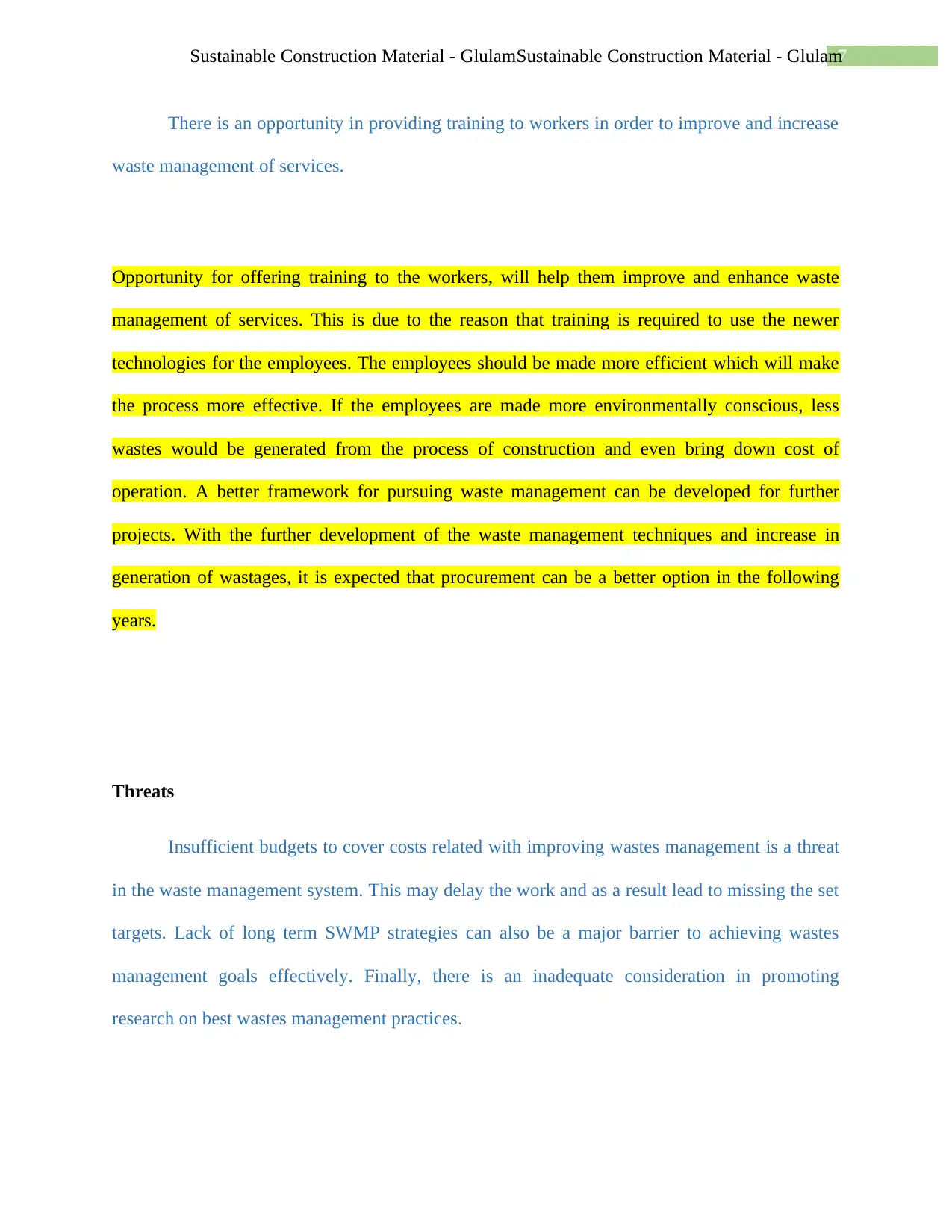
7Sustainable Construction Material - GlulamSustainable Construction Material - Glulam
There is an opportunity in providing training to workers in order to improve and increase
waste management of services.
Opportunity for offering training to the workers, will help them improve and enhance waste
management of services. This is due to the reason that training is required to use the newer
technologies for the employees. The employees should be made more efficient which will make
the process more effective. If the employees are made more environmentally conscious, less
wastes would be generated from the process of construction and even bring down cost of
operation. A better framework for pursuing waste management can be developed for further
projects. With the further development of the waste management techniques and increase in
generation of wastages, it is expected that procurement can be a better option in the following
years.
Threats
Insufficient budgets to cover costs related with improving wastes management is a threat
in the waste management system. This may delay the work and as a result lead to missing the set
targets. Lack of long term SWMP strategies can also be a major barrier to achieving wastes
management goals effectively. Finally, there is an inadequate consideration in promoting
research on best wastes management practices.
There is an opportunity in providing training to workers in order to improve and increase
waste management of services.
Opportunity for offering training to the workers, will help them improve and enhance waste
management of services. This is due to the reason that training is required to use the newer
technologies for the employees. The employees should be made more efficient which will make
the process more effective. If the employees are made more environmentally conscious, less
wastes would be generated from the process of construction and even bring down cost of
operation. A better framework for pursuing waste management can be developed for further
projects. With the further development of the waste management techniques and increase in
generation of wastages, it is expected that procurement can be a better option in the following
years.
Threats
Insufficient budgets to cover costs related with improving wastes management is a threat
in the waste management system. This may delay the work and as a result lead to missing the set
targets. Lack of long term SWMP strategies can also be a major barrier to achieving wastes
management goals effectively. Finally, there is an inadequate consideration in promoting
research on best wastes management practices.
Paraphrase This Document
Need a fresh take? Get an instant paraphrase of this document with our AI Paraphraser
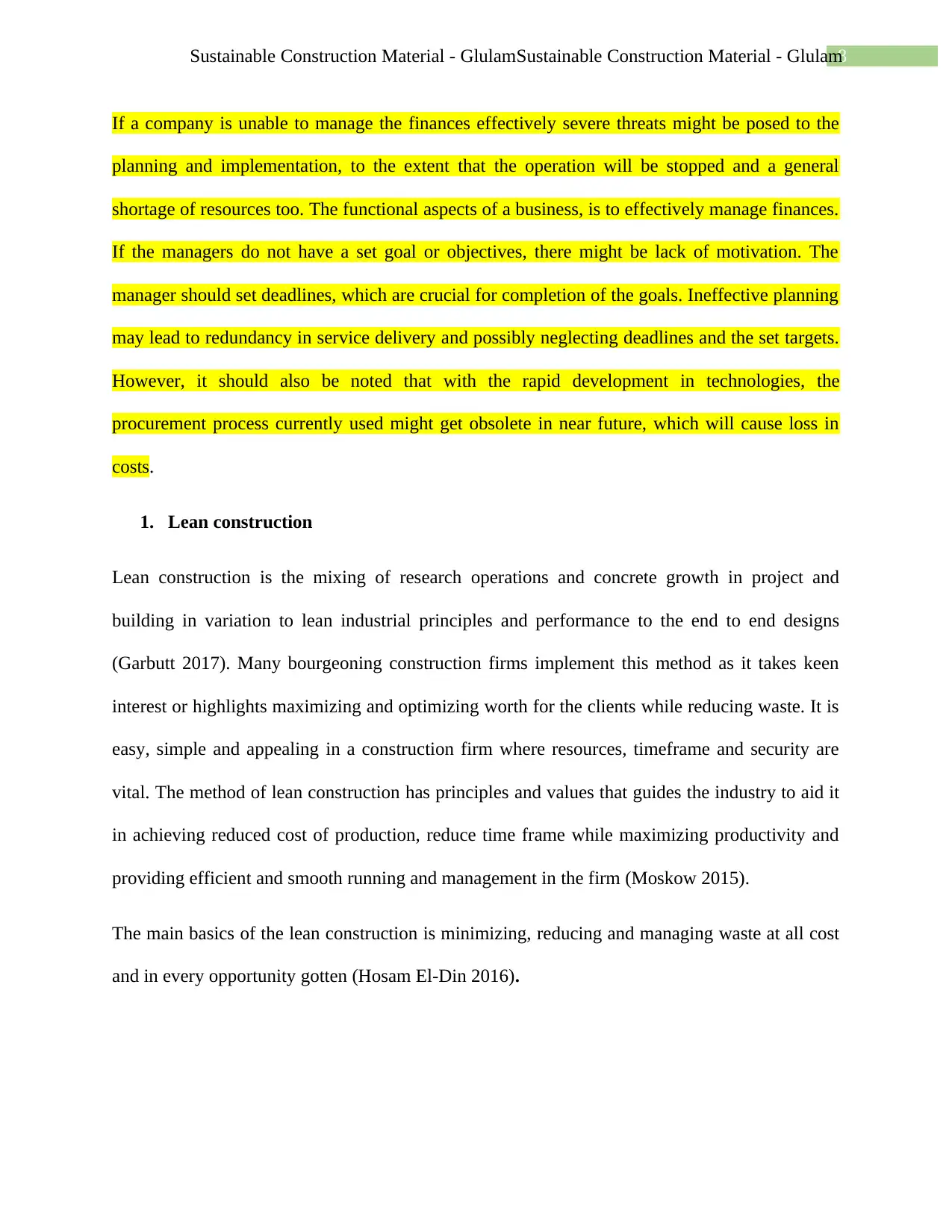
8Sustainable Construction Material - GlulamSustainable Construction Material - Glulam
If a company is unable to manage the finances effectively severe threats might be posed to the
planning and implementation, to the extent that the operation will be stopped and a general
shortage of resources too. The functional aspects of a business, is to effectively manage finances.
If the managers do not have a set goal or objectives, there might be lack of motivation. The
manager should set deadlines, which are crucial for completion of the goals. Ineffective planning
may lead to redundancy in service delivery and possibly neglecting deadlines and the set targets.
However, it should also be noted that with the rapid development in technologies, the
procurement process currently used might get obsolete in near future, which will cause loss in
costs.
1. Lean construction
Lean construction is the mixing of research operations and concrete growth in project and
building in variation to lean industrial principles and performance to the end to end designs
(Garbutt 2017). Many bourgeoning construction firms implement this method as it takes keen
interest or highlights maximizing and optimizing worth for the clients while reducing waste. It is
easy, simple and appealing in a construction firm where resources, timeframe and security are
vital. The method of lean construction has principles and values that guides the industry to aid it
in achieving reduced cost of production, reduce time frame while maximizing productivity and
providing efficient and smooth running and management in the firm (Moskow 2015).
The main basics of the lean construction is minimizing, reducing and managing waste at all cost
and in every opportunity gotten (Hosam El-Din 2016).
If a company is unable to manage the finances effectively severe threats might be posed to the
planning and implementation, to the extent that the operation will be stopped and a general
shortage of resources too. The functional aspects of a business, is to effectively manage finances.
If the managers do not have a set goal or objectives, there might be lack of motivation. The
manager should set deadlines, which are crucial for completion of the goals. Ineffective planning
may lead to redundancy in service delivery and possibly neglecting deadlines and the set targets.
However, it should also be noted that with the rapid development in technologies, the
procurement process currently used might get obsolete in near future, which will cause loss in
costs.
1. Lean construction
Lean construction is the mixing of research operations and concrete growth in project and
building in variation to lean industrial principles and performance to the end to end designs
(Garbutt 2017). Many bourgeoning construction firms implement this method as it takes keen
interest or highlights maximizing and optimizing worth for the clients while reducing waste. It is
easy, simple and appealing in a construction firm where resources, timeframe and security are
vital. The method of lean construction has principles and values that guides the industry to aid it
in achieving reduced cost of production, reduce time frame while maximizing productivity and
providing efficient and smooth running and management in the firm (Moskow 2015).
The main basics of the lean construction is minimizing, reducing and managing waste at all cost
and in every opportunity gotten (Hosam El-Din 2016).
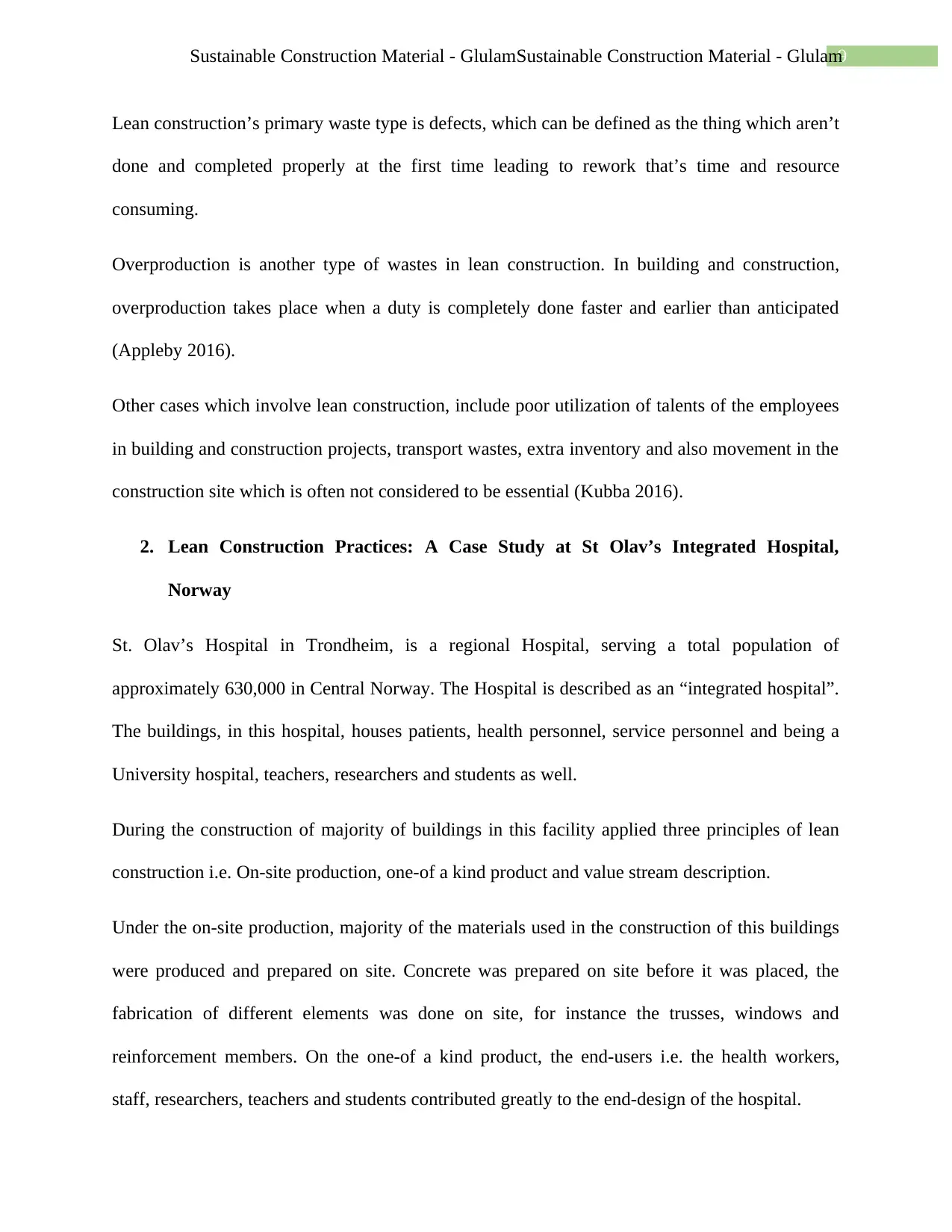
9Sustainable Construction Material - GlulamSustainable Construction Material - Glulam
Lean construction’s primary waste type is defects, which can be defined as the thing which aren’t
done and completed properly at the first time leading to rework that’s time and resource
consuming.
Overproduction is another type of wastes in lean construction. In building and construction,
overproduction takes place when a duty is completely done faster and earlier than anticipated
(Appleby 2016).
Other cases which involve lean construction, include poor utilization of talents of the employees
in building and construction projects, transport wastes, extra inventory and also movement in the
construction site which is often not considered to be essential (Kubba 2016).
2. Lean Construction Practices: A Case Study at St Olav’s Integrated Hospital,
Norway
St. Olav’s Hospital in Trondheim, is a regional Hospital, serving a total population of
approximately 630,000 in Central Norway. The Hospital is described as an “integrated hospital”.
The buildings, in this hospital, houses patients, health personnel, service personnel and being a
University hospital, teachers, researchers and students as well.
During the construction of majority of buildings in this facility applied three principles of lean
construction i.e. On-site production, one-of a kind product and value stream description.
Under the on-site production, majority of the materials used in the construction of this buildings
were produced and prepared on site. Concrete was prepared on site before it was placed, the
fabrication of different elements was done on site, for instance the trusses, windows and
reinforcement members. On the one-of a kind product, the end-users i.e. the health workers,
staff, researchers, teachers and students contributed greatly to the end-design of the hospital.
Lean construction’s primary waste type is defects, which can be defined as the thing which aren’t
done and completed properly at the first time leading to rework that’s time and resource
consuming.
Overproduction is another type of wastes in lean construction. In building and construction,
overproduction takes place when a duty is completely done faster and earlier than anticipated
(Appleby 2016).
Other cases which involve lean construction, include poor utilization of talents of the employees
in building and construction projects, transport wastes, extra inventory and also movement in the
construction site which is often not considered to be essential (Kubba 2016).
2. Lean Construction Practices: A Case Study at St Olav’s Integrated Hospital,
Norway
St. Olav’s Hospital in Trondheim, is a regional Hospital, serving a total population of
approximately 630,000 in Central Norway. The Hospital is described as an “integrated hospital”.
The buildings, in this hospital, houses patients, health personnel, service personnel and being a
University hospital, teachers, researchers and students as well.
During the construction of majority of buildings in this facility applied three principles of lean
construction i.e. On-site production, one-of a kind product and value stream description.
Under the on-site production, majority of the materials used in the construction of this buildings
were produced and prepared on site. Concrete was prepared on site before it was placed, the
fabrication of different elements was done on site, for instance the trusses, windows and
reinforcement members. On the one-of a kind product, the end-users i.e. the health workers,
staff, researchers, teachers and students contributed greatly to the end-design of the hospital.
⊘ This is a preview!⊘
Do you want full access?
Subscribe today to unlock all pages.

Trusted by 1+ million students worldwide
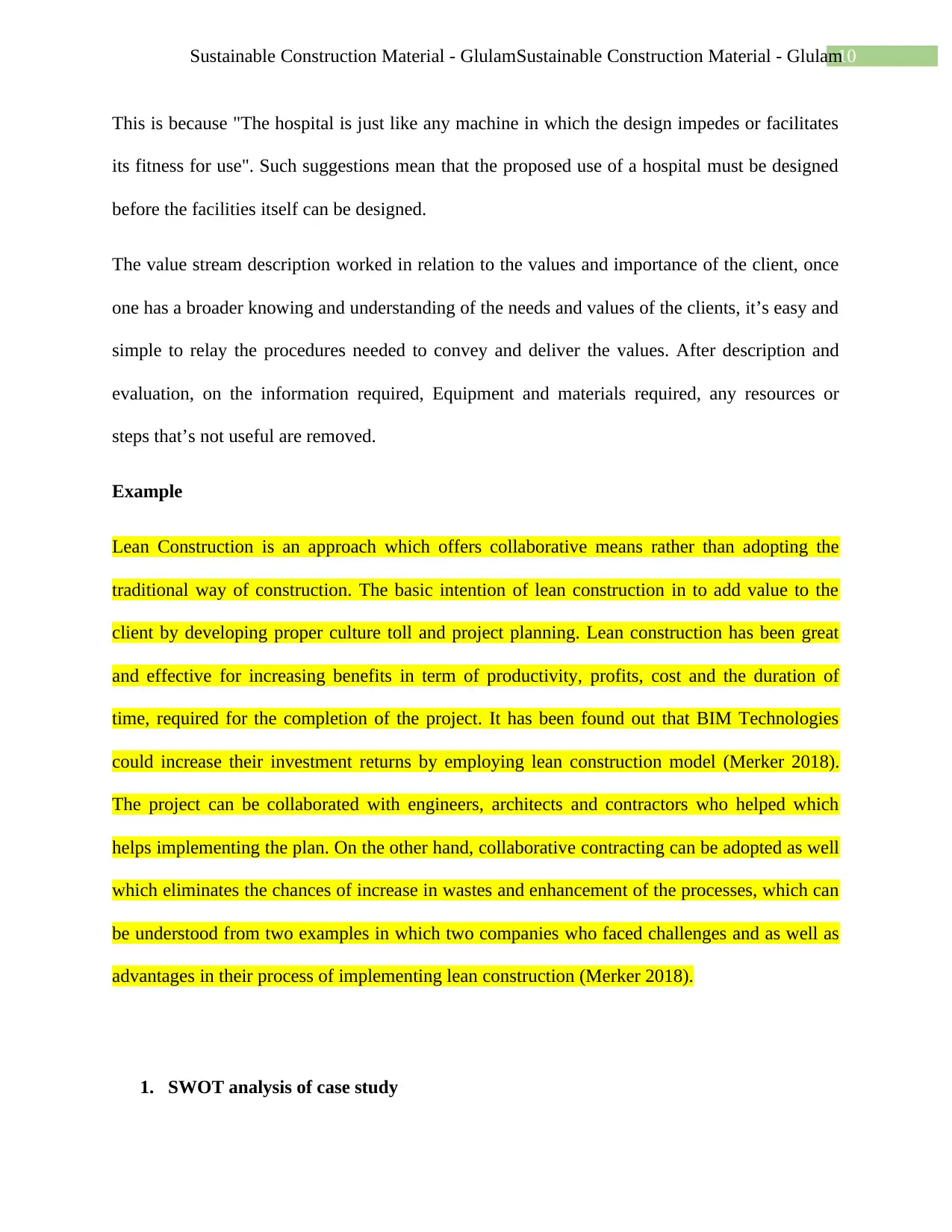
10Sustainable Construction Material - GlulamSustainable Construction Material - Glulam
This is because "The hospital is just like any machine in which the design impedes or facilitates
its fitness for use". Such suggestions mean that the proposed use of a hospital must be designed
before the facilities itself can be designed.
The value stream description worked in relation to the values and importance of the client, once
one has a broader knowing and understanding of the needs and values of the clients, it’s easy and
simple to relay the procedures needed to convey and deliver the values. After description and
evaluation, on the information required, Equipment and materials required, any resources or
steps that’s not useful are removed.
Example
Lean Construction is an approach which offers collaborative means rather than adopting the
traditional way of construction. The basic intention of lean construction in to add value to the
client by developing proper culture toll and project planning. Lean construction has been great
and effective for increasing benefits in term of productivity, profits, cost and the duration of
time, required for the completion of the project. It has been found out that BIM Technologies
could increase their investment returns by employing lean construction model (Merker 2018).
The project can be collaborated with engineers, architects and contractors who helped which
helps implementing the plan. On the other hand, collaborative contracting can be adopted as well
which eliminates the chances of increase in wastes and enhancement of the processes, which can
be understood from two examples in which two companies who faced challenges and as well as
advantages in their process of implementing lean construction (Merker 2018).
1. SWOT analysis of case study
This is because "The hospital is just like any machine in which the design impedes or facilitates
its fitness for use". Such suggestions mean that the proposed use of a hospital must be designed
before the facilities itself can be designed.
The value stream description worked in relation to the values and importance of the client, once
one has a broader knowing and understanding of the needs and values of the clients, it’s easy and
simple to relay the procedures needed to convey and deliver the values. After description and
evaluation, on the information required, Equipment and materials required, any resources or
steps that’s not useful are removed.
Example
Lean Construction is an approach which offers collaborative means rather than adopting the
traditional way of construction. The basic intention of lean construction in to add value to the
client by developing proper culture toll and project planning. Lean construction has been great
and effective for increasing benefits in term of productivity, profits, cost and the duration of
time, required for the completion of the project. It has been found out that BIM Technologies
could increase their investment returns by employing lean construction model (Merker 2018).
The project can be collaborated with engineers, architects and contractors who helped which
helps implementing the plan. On the other hand, collaborative contracting can be adopted as well
which eliminates the chances of increase in wastes and enhancement of the processes, which can
be understood from two examples in which two companies who faced challenges and as well as
advantages in their process of implementing lean construction (Merker 2018).
1. SWOT analysis of case study
Paraphrase This Document
Need a fresh take? Get an instant paraphrase of this document with our AI Paraphraser
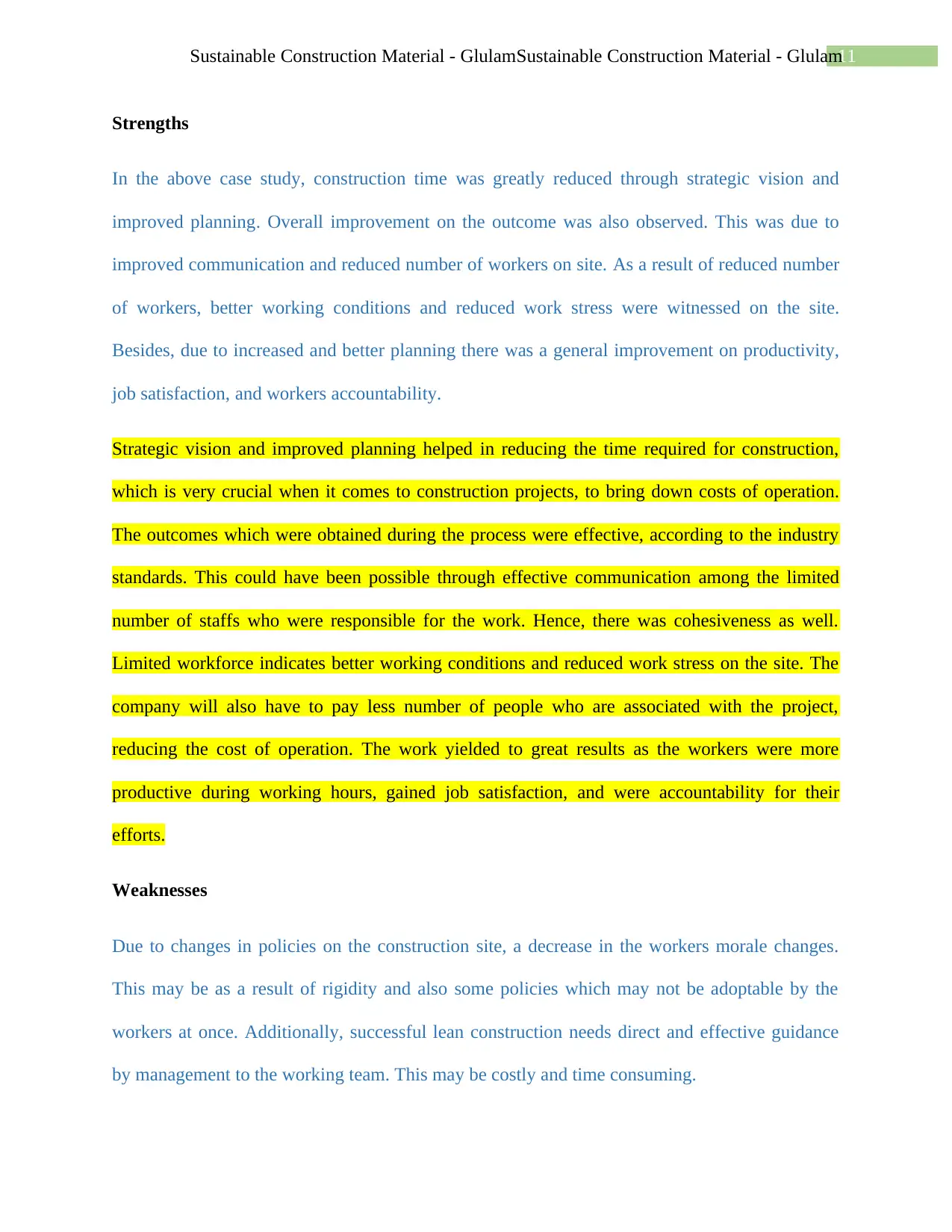
11Sustainable Construction Material - GlulamSustainable Construction Material - Glulam
Strengths
In the above case study, construction time was greatly reduced through strategic vision and
improved planning. Overall improvement on the outcome was also observed. This was due to
improved communication and reduced number of workers on site. As a result of reduced number
of workers, better working conditions and reduced work stress were witnessed on the site.
Besides, due to increased and better planning there was a general improvement on productivity,
job satisfaction, and workers accountability.
Strategic vision and improved planning helped in reducing the time required for construction,
which is very crucial when it comes to construction projects, to bring down costs of operation.
The outcomes which were obtained during the process were effective, according to the industry
standards. This could have been possible through effective communication among the limited
number of staffs who were responsible for the work. Hence, there was cohesiveness as well.
Limited workforce indicates better working conditions and reduced work stress on the site. The
company will also have to pay less number of people who are associated with the project,
reducing the cost of operation. The work yielded to great results as the workers were more
productive during working hours, gained job satisfaction, and were accountability for their
efforts.
Weaknesses
Due to changes in policies on the construction site, a decrease in the workers morale changes.
This may be as a result of rigidity and also some policies which may not be adoptable by the
workers at once. Additionally, successful lean construction needs direct and effective guidance
by management to the working team. This may be costly and time consuming.
Strengths
In the above case study, construction time was greatly reduced through strategic vision and
improved planning. Overall improvement on the outcome was also observed. This was due to
improved communication and reduced number of workers on site. As a result of reduced number
of workers, better working conditions and reduced work stress were witnessed on the site.
Besides, due to increased and better planning there was a general improvement on productivity,
job satisfaction, and workers accountability.
Strategic vision and improved planning helped in reducing the time required for construction,
which is very crucial when it comes to construction projects, to bring down costs of operation.
The outcomes which were obtained during the process were effective, according to the industry
standards. This could have been possible through effective communication among the limited
number of staffs who were responsible for the work. Hence, there was cohesiveness as well.
Limited workforce indicates better working conditions and reduced work stress on the site. The
company will also have to pay less number of people who are associated with the project,
reducing the cost of operation. The work yielded to great results as the workers were more
productive during working hours, gained job satisfaction, and were accountability for their
efforts.
Weaknesses
Due to changes in policies on the construction site, a decrease in the workers morale changes.
This may be as a result of rigidity and also some policies which may not be adoptable by the
workers at once. Additionally, successful lean construction needs direct and effective guidance
by management to the working team. This may be costly and time consuming.
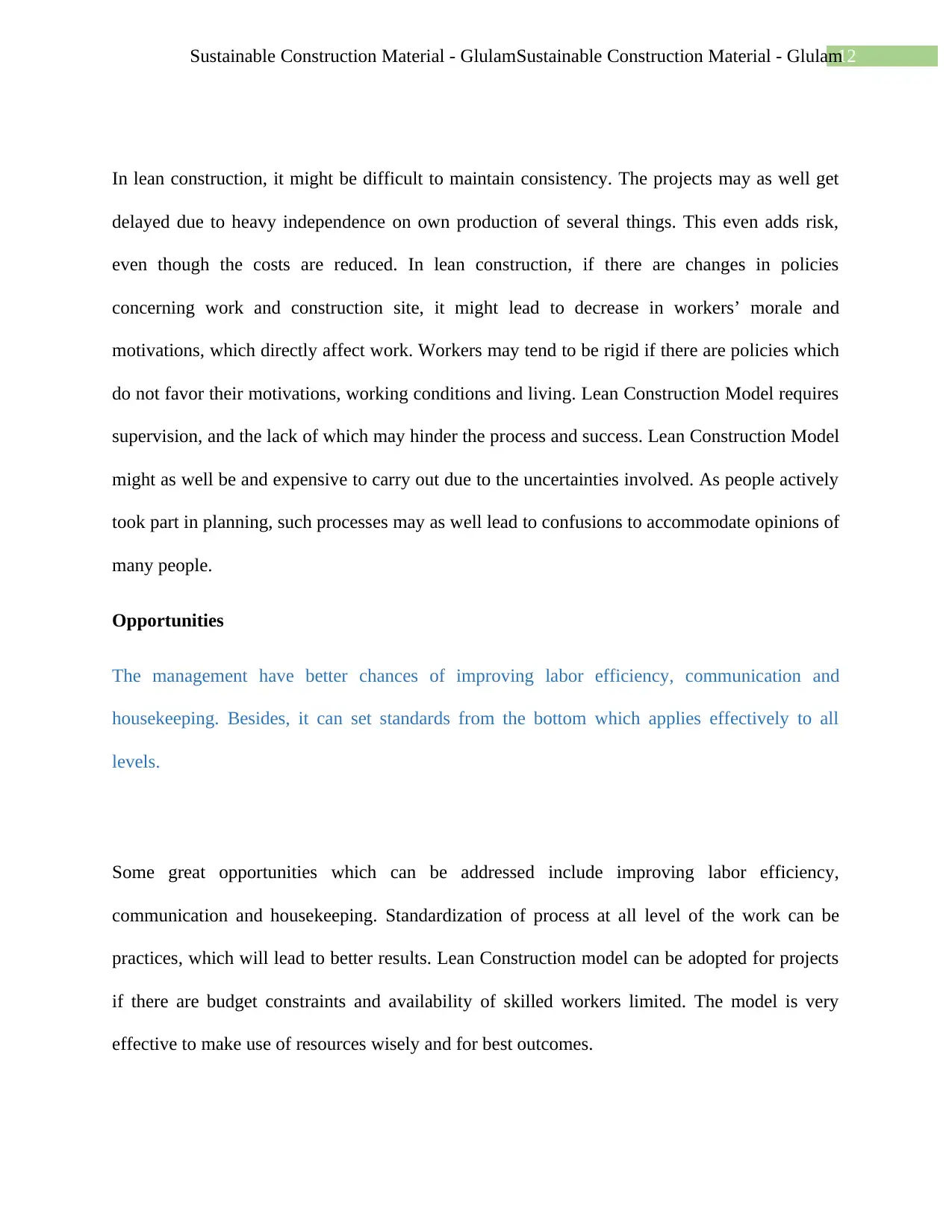
12Sustainable Construction Material - GlulamSustainable Construction Material - Glulam
In lean construction, it might be difficult to maintain consistency. The projects may as well get
delayed due to heavy independence on own production of several things. This even adds risk,
even though the costs are reduced. In lean construction, if there are changes in policies
concerning work and construction site, it might lead to decrease in workers’ morale and
motivations, which directly affect work. Workers may tend to be rigid if there are policies which
do not favor their motivations, working conditions and living. Lean Construction Model requires
supervision, and the lack of which may hinder the process and success. Lean Construction Model
might as well be and expensive to carry out due to the uncertainties involved. As people actively
took part in planning, such processes may as well lead to confusions to accommodate opinions of
many people.
Opportunities
The management have better chances of improving labor efficiency, communication and
housekeeping. Besides, it can set standards from the bottom which applies effectively to all
levels.
Some great opportunities which can be addressed include improving labor efficiency,
communication and housekeeping. Standardization of process at all level of the work can be
practices, which will lead to better results. Lean Construction model can be adopted for projects
if there are budget constraints and availability of skilled workers limited. The model is very
effective to make use of resources wisely and for best outcomes.
In lean construction, it might be difficult to maintain consistency. The projects may as well get
delayed due to heavy independence on own production of several things. This even adds risk,
even though the costs are reduced. In lean construction, if there are changes in policies
concerning work and construction site, it might lead to decrease in workers’ morale and
motivations, which directly affect work. Workers may tend to be rigid if there are policies which
do not favor their motivations, working conditions and living. Lean Construction Model requires
supervision, and the lack of which may hinder the process and success. Lean Construction Model
might as well be and expensive to carry out due to the uncertainties involved. As people actively
took part in planning, such processes may as well lead to confusions to accommodate opinions of
many people.
Opportunities
The management have better chances of improving labor efficiency, communication and
housekeeping. Besides, it can set standards from the bottom which applies effectively to all
levels.
Some great opportunities which can be addressed include improving labor efficiency,
communication and housekeeping. Standardization of process at all level of the work can be
practices, which will lead to better results. Lean Construction model can be adopted for projects
if there are budget constraints and availability of skilled workers limited. The model is very
effective to make use of resources wisely and for best outcomes.
⊘ This is a preview!⊘
Do you want full access?
Subscribe today to unlock all pages.

Trusted by 1+ million students worldwide
1 out of 24
Related Documents
Your All-in-One AI-Powered Toolkit for Academic Success.
+13062052269
info@desklib.com
Available 24*7 on WhatsApp / Email
![[object Object]](/_next/static/media/star-bottom.7253800d.svg)
Unlock your academic potential
Copyright © 2020–2025 A2Z Services. All Rights Reserved. Developed and managed by ZUCOL.




